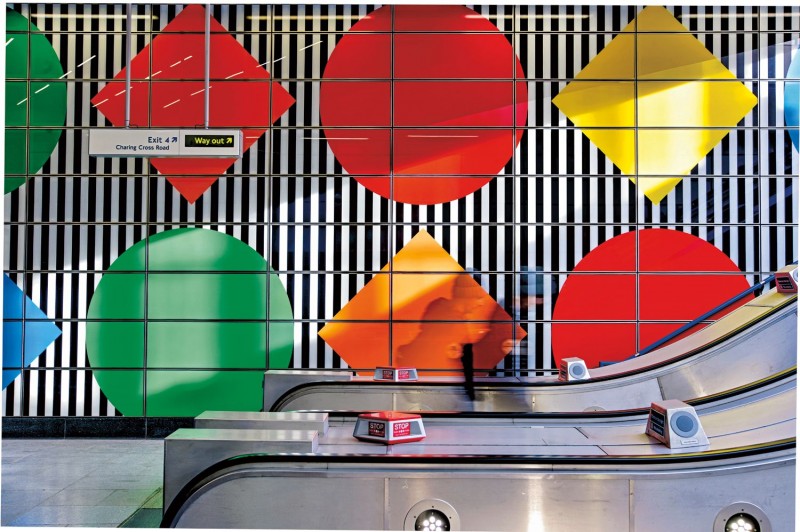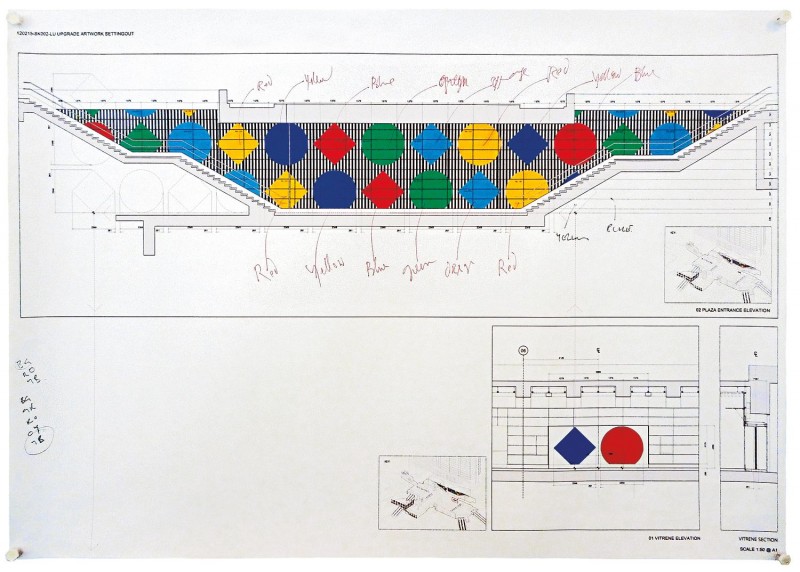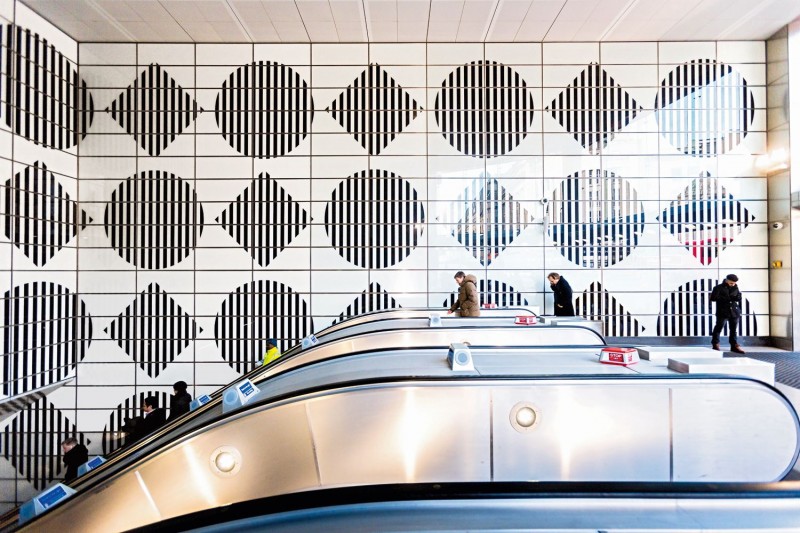Commissioning the Work
As an artist who has made many large-scale works in the public realm, including several as part of major building projects, Daniel Buren is accustomed to the length of time it can take to realize a commission. Even with that experience, however, the installation at Tottenham Court Road Station has required an impressive level of commitment on his part, being almost a decade in the making. What is more, he is perhaps the only person who has seen the evolution of the work from start to finish.

The process began back in 2007 when I, as the then head of Art on the Underground, brought together a range of stakeholders to form a selection panel for the commission. In its first meeting, the group approved a brief as well as a longlist of candidates who might be considered. The brief outlined the challenge and opportunity for the artist: to create a permanent work for Tottenham Court Road that had a clear presence and impact on its architecture; to produce an installation that allowed the London Underground brand to remain prominent within the overall design, and would not detract from the signage guiding passengers around the station; and to develop a proposal that complemented the mosaics by Eduardo Paolozzi that were already in place. There were additional constraints, too, such as the use of only certain permissible materials, and the requirement to ensure a minimal level of maintenance. Such challenging conditions, typical of the complex nature of many public sites, would make the commission a demanding but stimulating experience for the selected artist. It was crucial that we arrived at a shortlist of individuals who could create world-class art under such constricted circumstances.
With all of this in mind, I invited Daniel to make a proposal. Because of his track record, approach and range of work produced since the 1960s, we were confident that he would produce a vision that was unique and striking. The sketches outlining his initial ideas confirmed that belief, and the panel received them enthusiastically. Our decision to award him the commission noted that his proposal would be bold and assertive, yet subtle; that it would work well as part of the architecture, yet would be unmissable and memorable.

From the beginning, the process was complicated, with many people at Transport for London and beyond necessarily involved in approving and moving forward the commission. Our selection of Daniel was the start of years of meetings, site visits, sample viewings and constant liaison between the artist, architects and contractors that continued until the station finally opened. I and my team followed the construction work closely, ensuring that his concept remained a central element of the plans, from the models and drawings through to the redeveloped station. It was important that everyone could envisage the proposed multi-faceted installation, especially as we knew that it would take so long to come to fruition.
Having established the partnerships for the commission, and having put all the necessary elements in place to ensure the success of this ambitious project, I found myself handing over the baton to Eleanor Pinfield, my successor as head of Art on the Underground, just as the first part of the work, the black-and-white striped shapes at the Oxford Street entrance, was completed and revealed in 2014. After that, I remained in touch with the process, keeping up to date with each of the latest developments, issues and changes, but above all anticipating the moment when this important permanent public art work could finally be unveiled in its entirety.
To view art works in situ years after they were conceived may be a frequent experience for Buren, but there is undoubtedly something uncanny about it. The architects’ two-dimensional, computer-generated renderings of the station and the works within it were so accurate that encountering them physically in reality is a strange experience. There is an odd sense of familiarity that is not in keeping with visiting a roomspace for the first time – one that, until only recently, didn’t not even even exist.

Now that we can see the work installed as planned, we can reflect on the commission itself. It is possible to understand and admire Buren’s ability to visualize the impact he would have on the architecture and to comprehend why his apparently simple proposition was chosen. The process has unfolded in parallel with significant changes within Art on the Underground, in some way charting the growth and development of the programme over those years. The completion of this project represents a significant milestone in the history and trajectory of London Underground and its art programme, which, by building on the unique heritage of art and design on the Tube, has secured a clear and necessary niche within it. The realization of Buren’s commission signifies a kind of coming of age for the programme, a maturing as it grows towards its firmly grounded future.

With the artist’s vision now fully realized, it can at last enter the public realm and discourse: to be looked at and engaged with. This book is part of that process. Millions of people will pass through the station over the coming years, and they will encounter Buren’s wonderfully simple but effective intervention as they do so. They will engage with it, or perhaps they will not; but if the art works resonate with the public as others before them have done, they will generate debate – certainly, Paolozzi’s mosaics have been polarizing opinion since they were created. Personally, I hope that each time that people use the ticket hall at Tottenham Court Road, they will take something from the work, even if it is simply to think a little differently about the space because of the intervention that Buren has made. I hope also that I will be just one among many, many people who will want to congratulate and thank Daniel Buren for taking so much time to bring us this wonderful permanent new work as part of the growing legacy and collection of art across London Underground.
This essay was written for Daniel Buren Underground published in 2017 by Art Books Publishing Ltd to mark the completion of the commission Diamonds and Circles works in situ for Tottenham Court Road Underground station.